Mining and Quarrying Layouts – Page 1
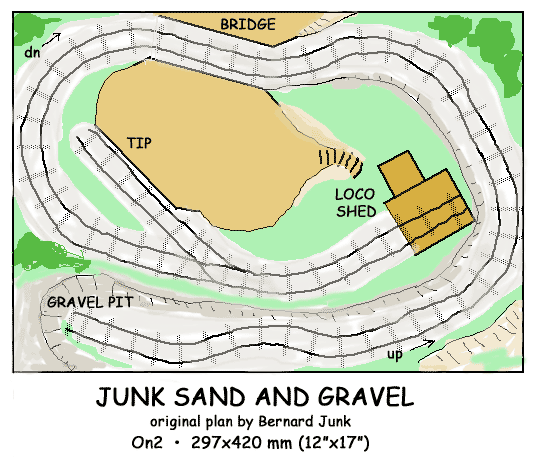 One of the best known and frequently modeled micro layouts is this classic, designed by Bernard Junk in 1991. This little lline hauls quarried minerals (sand, gravel, slate, limestone or whatever) up the hill to a tip, where the load is emptied into a waiting truck or lorry. The design is so compact that it can be built in O scale (On18, On2, or On30) in just 12″x17″ — in fact, it was originally designed to fit on a sheet of A3 sized paper!
One of the best known and frequently modeled micro layouts is this classic, designed by Bernard Junk in 1991. This little lline hauls quarried minerals (sand, gravel, slate, limestone or whatever) up the hill to a tip, where the load is emptied into a waiting truck or lorry. The design is so compact that it can be built in O scale (On18, On2, or On30) in just 12″x17″ — in fact, it was originally designed to fit on a sheet of A3 sized paper!
This clever layout has been constructed over the years by many excellent modelers in gauges ranging from HOn30 to Gn15. Bernard’s design has been redrawn here to include the original track patterns caused by his interesting modeling of portable track sections (the prototype’s version of Snap Track or Setrack). Curve radii are about 9 cm (3.5″) — roughly 13-14 feet in O scale, exactly like the prototype.
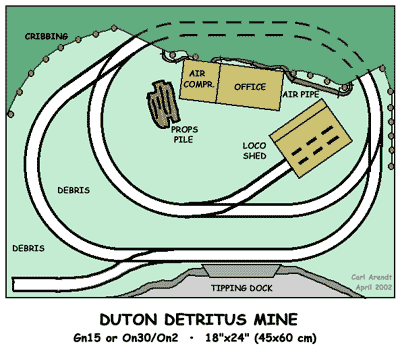 Here’s a playground for your new Sidelines trammer in Gn15 or your hard-working battery mine loco in On30/O16.5. Inspired by a layout of Raymond Duton, here’s a mine producing that little-known mineral, detritus. So we have the Duton Detritus Mine.
Here’s a playground for your new Sidelines trammer in Gn15 or your hard-working battery mine loco in On30/O16.5. Inspired by a layout of Raymond Duton, here’s a mine producing that little-known mineral, detritus. So we have the Duton Detritus Mine.
Occupying only three square feet, this little mining company only owns a few skips and a battery or diesel locomotive. The design also can be operated with two locomotives, if detritus suddenly increases in value and extra funds are available!
There are two “adits” which conveniently link a backstage continuous circuit concealed by rising terrain. Rear access can permit loading and unloading the skips, to avoid the “taking the stuff back to the mine” appearance.
The front and center location is reserved for an automatic tipping device that you will create to empty the detritus from your skips into the trucks waiting below. An additional siding is provided for hauling and dumping the incredible amounts of debris that seem to accumulate around all mining operations. You’ll need a couple extra skips for this operation.
In probably the closest approach to Perpetual Motion that model railroading will ever make, we have this astounding layout from Jack Trollope, Jaxcilli Industries. He has used six square feet in his design, much more than our micro layouts occupy. However, this is a standard gauge layout … if we were to reduce the radius to our customary six inches, we could no doubt reduce the ultimate size of the layout to under four square feet … definitely micro territory! Read Jack’s description below.
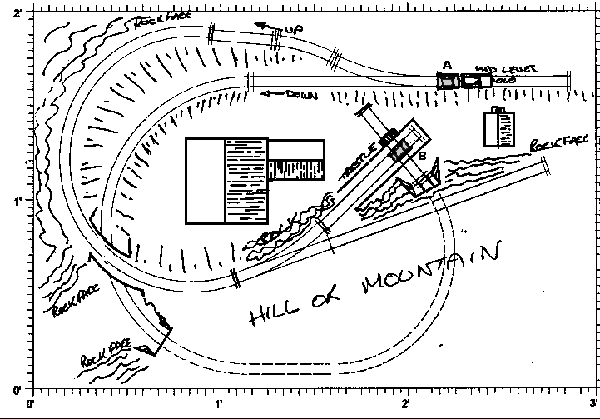 Jaxcilli Industries
Jaxcilli Industries
by Jack Trollope
This trackplan, as drawn in HO Scale, fits into 36″x24″ but could be 30″x24″ without losing any trackage, or operational(???) possibilities.
It works thus:-
Loco pushes empty wagon A from mid-level, down under the bridge and through the tunnel so that it is positioned under the loading chute from the trestle.
Wagon B is unloaded via the chute into wagon A.
Loco pulls A back up to mid-level and then pushes it up the incline to the trestle, where it adds (now empty) wagon B to wagon A.
Loco reverses with both wagons until all are clear of the switch, the switch is thrown and the wagons are pushed into the siding.
B is uncoupled, loco + A reverse through the switch, it is thrown again, and A is pushed onto the trestle, and left in the unloading position.
Loco now goes and collects wagon B, pulls it down to mid-level and the cycle starts again.
I haven’t drawn in all the various rock faces to avoid cluttering the drawing. It could be a good scenic project.
Minimum radius is 8″ and switches are Peco Setrak, 1xLH and 1xRH. Using small wagons, trains could probably consist of 2 wagons although I have only shown single wagons in the plan.
The name explains it all .
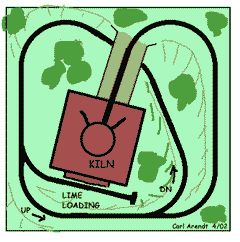 As a variation on (and a salute to) Jaxcilli Industries, here’s a tiny 14″x14″ (36×36 cm) layout that performs the same magical ritual. It’s based on a Zimbabwe Lime Kiln and is best built in On18/O9 or HOn30/OO9. Two small, four-wheel gondolas (wagons) are required, along with a tiny “critter” to haul them around the 3″ (76mm) radius curves.
As a variation on (and a salute to) Jaxcilli Industries, here’s a tiny 14″x14″ (36×36 cm) layout that performs the same magical ritual. It’s based on a Zimbabwe Lime Kiln and is best built in On18/O9 or HOn30/OO9. Two small, four-wheel gondolas (wagons) are required, along with a tiny “critter” to haul them around the 3″ (76mm) radius curves.
To begin, empty car A is placed in front of the kiln at the lower level “Lime Loading” position. Car B, full of limestone, is pulled by the loco in a clockwise direction for as many circuits as you can stand; then the switch is thrown and Car B is pushed up the steep grade to the top. This is where the limestone is charged into the kiln.
Car B is dumped into the kiln. Through careful craftsmanship, a system of invisible chutes inside the kiln routes the material to the bottom where it erupts from the loading chute and fills Car A. The loco then reverses the positions of the two cars, and the cycle continues ad infinitum, for endless hours of fascinating fun with model railroading!
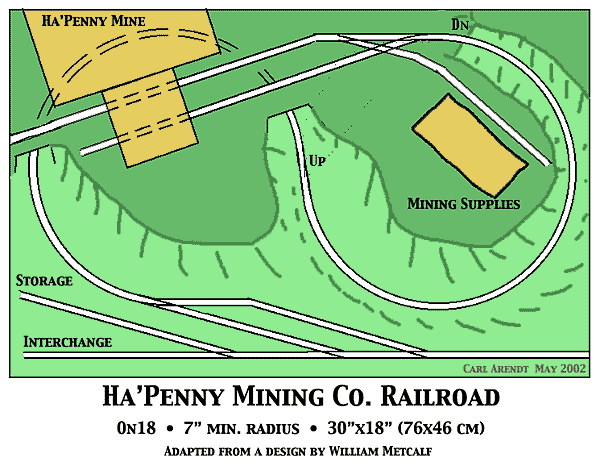 Bill Metcalf builds and operates a delightful outdoor G-scale railroad, the Sludgewell Bottled Water Co. RR. But he also expresses a liking for small and simple track plans where every spur and line does at least double duty and operating problems are most of the point [a good description of a micro layout! –ed.]. To illustrate, Bill designed a nifty 4’x8′ mining layout, Penny Mining Co. Railroad, and presented it on his refreshing web site.
Bill Metcalf builds and operates a delightful outdoor G-scale railroad, the Sludgewell Bottled Water Co. RR. But he also expresses a liking for small and simple track plans where every spur and line does at least double duty and operating problems are most of the point [a good description of a micro layout! –ed.]. To illustrate, Bill designed a nifty 4’x8′ mining layout, Penny Mining Co. Railroad, and presented it on his refreshing web site.
Wistfully he wrote me, “It would be Interesting to reduce the [Penny Mine] concept down to a very small size … but a reversing loop is not exactly a space-saving configuration.” Challenged, I proceeded to design the Ha’Penny Mining Co. Railroad, a 30″x18″ (76×46 cm) streak of rust that presents some interesting operating challenges in getting the supplies and empty mine cars up the hill and bringing the mineral tonnage down.
Alas, as Bill pointed out, there’s not really enough room to feature the Penny Mine switching puzzle created by placing a mine tipple on the main line within a reversing loop (balloon). Instead, the micro version focuses on figuring things out at the bottom, before starting the climb. The only firm operating rule is that the locomotive must always be on the downhill side of the heavily loaded cars full of whatever it is they mine up there. And of course, the loaded cars are delivered to the interchange — same place where supplies and mining equipment arrive.
The drawing is arranged for On18/O9 trains using 9 mm gauge, but the 7-inch curves are generous enough to allow virtually any gauge/scale combination to work, from Gn15 to HOn30. The limiting factor wil be how steep a grade you can tolerate to get the trains up and over.
And, oh yes — I couldn’t resist drawing a version of Bill’s Penny Mine reversing loop that fits inside the four-square-foot size limit for a micro layout! Here’s Farthing Mining Co. RR, which hauls supples and empties up the hill from the hidden offstage interchange to the mine and returns with loads of minerals. In Bill’s words: “It would be great with some sort of electric mine loco and three or four short ore cars. The loco always has to end up on the outgoing end of the train.”
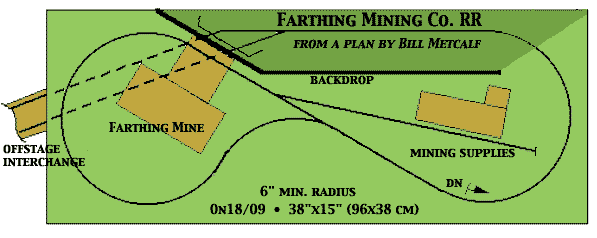
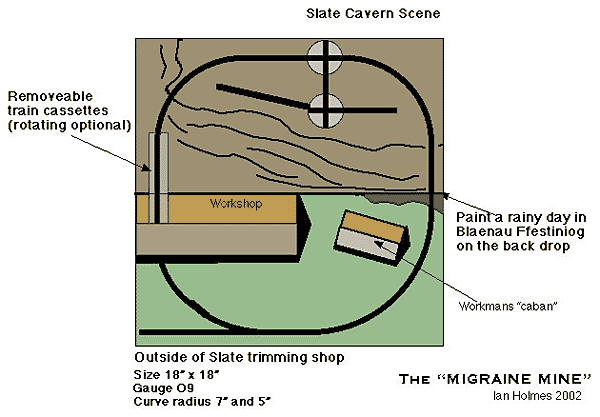 Ian Holmes has designed this tiny Welsh slate-quarrying railway to recapture some memorable experiences. He describes the Migraine Mine (so named because he had one while drawing it up) this way:
Ian Holmes has designed this tiny Welsh slate-quarrying railway to recapture some memorable experiences. He describes the Migraine Mine (so named because he had one while drawing it up) this way:
“Scale is O16.5 or 09 (On30 or On18). The subject, slate mines, is my absolute favourite as I spent my impressionable years riding the narrow gauge railways of North Wales.
“Slate caverns are incredible places. Slate was quarried out of the inside of mountains leaving vast caverns big enough to hold Saint Paul’s Cathedral. An incredible testimony to the slate industry. That is what the top scene represents, a smaller cavern on the way to a larger one deeper in the mountain.
“This cavern is still being worked, miners can be seen on cave walls drilling holes ready to lay the dynamite. Once in a while a battery electric trammer passes by from deep in the mountain with a large slab of slate, on its way to the trimming shop in the next scene. The loco emerges from inside the mountain and makes its way into the trimming shop, where hidden from the public’s gaze the train can be swapped out on a cassette, as is done on the Apple Valley Light Railway.
“Trains would consist of empty slate wagons going into the mountain and full ones coming out, with worker trains carrying the miners to and from their jobs. Not bad for a simple circle of track!
“The real challenge would be to make the Cavern scene dark enough that you could see that the workers all had tiny lights on their helmets working courtesy of grain of wheat light bulbs.”